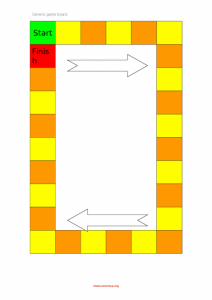Search
User login
Topic “Early Years (0-5yrs)”
Early Years (0 to 5 years)
Developing awareness that an object exists when out of sight
| Activity/strategy name and materials required | How to do the activity | Key principles for doing the activity and comments |
|---|---|---|
| Peek-a-boo - A toy that your child is motivated by. - A small blanket. |
| Only do this activity when the child is interested in the toy and is likely to want to continue to play with it Keep other distractions to a minimum - if there are other toys for them to play with they may not look for the hidden toy If the child is not aware that the toy still exists, gain their attention and lift up the cloth. 'Here it is!' Let the child play with the toy again |
Developing turn taking using sensory toys
| Activity/strategy name and materials required | How to do the activity | Key principles for doing the activity and comments |
|---|---|---|
| Sensory Suitcase Use a small box or bag to collect toys which target different sensory areas e.g. Auditory (noisy toys) toys (rattles, squeakers, shakers, musical items, drums etc.) Visual toys (flags, streamers, Slinkies, spinners, bubbles, flashing items, torches, pop-up toys, windmills etc.) Tactile toys (toys that feel different) (balls of different textures to squeeze, brushes of different textures to be tickled with, materials e.g. velvet, sandpaper, feathers, pots of rice/macaroni to feel, Play dough to squeeze/cut ) Scented toys (play dough, Plasticine, some rubber toys) | 1. Collect some toys from each of the sensory categories described. 2. Store the toys in a container which you use only for this specific activity and is otherwise stored away from children. 3. Find a quiet comfortable place to work either at a table or on the floor. Try to make sure the child cannot easily run off or get distracted. 4. Make a show of shaking the suitcase and seeming happy about the approaching activity. 5. Take out two toys from different sensory categories and place them in front of the child - note which category of item the child chooses/reaches for and put the other item back in the suitcase. 6. Allow the child a short time to enjoy the item chosen then say 'Your name's turn' (e.g. "Mary's turn") and gently but firmly take the item for your turn. 7. Use the toy for a short time then offer it the child again. Say 'Child's name's turn'. 8. Repeat a few times but stop before the child gets bored. 9. Start the process again by offering the child a choice of toys from two different sensory categories and then follow the turn taking routine. 10. Continue with the activity for approximately 10 minutes - stop before the child gets bored. 11. Store the sensory suitcase in a secure place until the next session.
| These activities are based on a child's sensory preferences. Some children love visual toys but are frightened of noisy (auditory) toys. Accept these preferences and work with the sensory areas the child is comfortable with. Some children will choose some kinds of noisy toys and reject others or show fear when presented with others. Some children are frightened of feathers but love being tickled with a shaving brush. Experiment and observe! Sensory preferences can change over time as well! Keep the activity fun and show that you are enjoying it too! Make the activity time limited so that it stays special. Do the activity regularly and change the items used from time to time. |
| Create Colourful Patterns Use a selection of the following: Paint pots and brushes, felt tips, computer painting programme, pots with different coloured bits of paper to stick and a sheet of paper. | ||
| Messy Play Use, for example, one of the following sets of items: Sand tray with spades, pots etc. Water tray with pots, sieves, pourers etc Rice tray with pots and pourers etc |
Name common objects
| Activity/strategy name and materials required | How to do the activity | Key principles for doing the activity and comments |
|---|---|---|
| Story books and pictures | Describe and look for things and actions in story books and pictures. | |
| Fishing game pictures with paper clips attached, magnetic fishing rods, 'pond' e.g. a flat box | Put cards in the box, take turns to fish for a picture, say/sign what is fished out. | Give the pupil time to name the object. Help them by giving a prompt (e.g. a forced alternative, the first sound. or the word or sign to repeat) |
| 'Hide the fish' Eight picture cards, small piece of paper with a fish drawn on it | ||
| Collages Pictures of everyday objects, background pictures (Black Sheep Sentence Builder and Narrative Packs have some good ones) | Give the pupil time to name the object. Help them by giving a prompt (e.g. a forced alternative, the first sound. or the word or sign to repeat) Have each child take a turn at thinking of other items they could add to that collage. They can draw these on. | |
| Jotters Pictures of everyday objects from class and outside. A blank jotter book | Have the child take a turn at thinking of other items they could add | |
| Odd one out activites Pictures of everyday objects from class and outside | Give the pupil time to think about it. Help them by giving a prompt (e.g. a forced alternative, talking about where you find each object and what you do with it.) |
Starts to greet familiar people using a reward chart system
| Activity/strategy name and materials required | How to do the activity | Key principles for doing the activity and comments |
|---|---|---|
| Says ‘Hello’ to 3 familiar people
If you don't already have a symbol for "hello" you can find one in the Commtap Symboliser.
|
| The length of these instructions show that this is quite a difficult routine to learn! The object of the activity is give the child conventional politeness. Allow time to develop this skill.
|
Develop an awareness that different people have different preferences
| Activity/strategy name and materials required | How to do the activity | Key principles for doing the activity and comments |
|---|---|---|
| I like/ I don’t like Laminated A3 sheet divided in half with a line, with an "I like" symbol on one side and an "I don’t like" symbol on the other side (symbols could be a smiley face and a sad face); Assortment of pictures of food, animals, cartoon characters, games etc.; Use Velcro or blue-tak to attach pictures to board. You can also get picture symbols from the Commtap Symboliser.
|
| |
| Jump in the hoop Large plastic hoop. Assortment of pictures of food, animals, cartoon characters, games etc. (if needed). |
Able to play simple action games and respond to greetings
| Activity/strategy name and materials required | How to do the activity | Key principles for doing the activity and comments |
|---|---|---|
| Playing action games Action toys Action nursery rhymes | 1. Use any toy which you need to post or press a key or push a part to make something happen e.g. rolling marbles down a kitchen roll holder, catching fish with a magnet and putting into a pond, press a button and the toy pops up. Set the toy up and take turns to have a go. 2. Play round and round the garden type games. Start the game and pause before the exciting end part and wait for the child to indicate he/she wants you to continue by the child looking at you or moving your hand to show he/she wants more. | Child learns to take turns Child accepts ending and starting a turn |
| Child says bye. | Be consistent in the ritual. The only thing that varies is the names of the people involved. | |
| Child greets familiar adults Soft toys | ||
| Child sits in a small group for story time. Comfy bean bags and favourite book |
Generic game track
A coloured track which, along with dice and counters for example, could be used to make a variety of activities into a game - for example, shake the dice, move the counter, and if you land on an orange square, pick a card and describe what is on it.
Created 18 October 2012; updated 19 July 2015.
Sources of Information, Support and Additional Resources
Created 10 October 2012; updated 2 August 2025.
Sources of Information, Support and Additional Resources
This is a list of some sources of information, support and resources in the UK. You can edit this page, or you could create another page for organisations in your country.
Information and Support
Number action rhymes
Below are some action number rhymes which you can use to develop children’s understanding of numbers and also encourage them to initiate and continue the song/interaction with you.
Remember to sing these songs a few times with your child and show them how to move their hands/body by modelling it yourself.
Text mangle tool
See the "comments" link associated with this page for more information about this tool.
What this tool is for
The purpose of this tool is to be able to get a flavour of:
- What an early reader might get from text;
- What can be gained from text where only a selected number of high frequency words are used;
- How a strategy of signing could assist comprehension;
- Or...to create your own Jaberwocky poem!
See the comments page for more information on this tool.
use switches to turn something on or off
| Activity/strategy name and materials required | How to do the activity | Key principles for doing the activity and comments |
|---|---|---|
| Keeping cool: learning to sustain an action Fan, (with optional ribbons attached) Mains switch control box | Configure the controller so that the fan is on as long as the switch is held down. Hold down the switch and let the child/adult feel the breeze. Let them do the same. | The child/adult should experience holding down the switch and feeling the breeze. On release the breeze stops. State, "On" and "Off" as you and the child/adult press and release the switch. |
| Learning to use a switch to turn a device on Fan (as above) | As either of you press the switch say, "on." When it stops say "off." Show them the effect of the breeze, blowing your hair or rubbing your arms because it is cold. | |
| Switching a device on and off (Do this in a subsequent session after the child/adult has understood the process in the above activity). A device to control, for example: fan toy computer monitor bubble machine | Let the child/adult turn the fan on and off modelling the vocabulary as you go. Reinforce this learning with different devices at different times and places. |
Make a choice using two switches
| Activity/strategy name and materials required | How to do the activity | Key principles for doing the activity and comments |
|---|---|---|
| Establishing motivators Items/activities the student may be interested in. Items/short activities the student is not interested in. |
| Don't use two things which are motivating for the student as you won't be able to tell whether they've succeeded in expressing a choice or not. |
| Establishing the switches to use Appropriate switches to use Typically you might start off with a couple of large recordable buttons (for example "Big Macs". You may have already established this with single switch work and established that they can make something happen with a single switch). | You may need to work with an occupational therapist to establish what type of switch a student can use - particularly if they have complex physical difficulties. | |
| Making choices Pair of switches Motivating and un-motivating items/activities (see the activity "establishing motivators" above) | If they don't press a switch you may need to:
Consistency of pressing Do they appear to be pressing one switch more than another, or do they appear to be choosing the switch randomly? Swapping the switches around from time to time will help you to know this. If they aren't consistent, you could try making the switches more different, for example:
You could also try:
|
Support Commtap to keep it online
Thank you for visiting Commtap.
Please read this message as it is extremely important.
- Visitor donations mean we can continue to host over 1,000 free activities to support speech, language, and communication development.
- Visitor donations mean we can continue to provide free resources to address a wide range of communication needs, including limited speech or language, interaction challenges, and needs associated with conditions such as developmental language disorder, autism, and cerebral palsy.
- Visitor donations mean we can continue to provide resources to support the work of speech and language therapists, teachers, teaching assistants, parents, and carers.
- Visitor donations mean we can continue to provide the free key word sign dictionary (bks.org.uk) which has over 2,000 Makaton and Signalong signs.
We know that not everyone is able to afford to pay to access these resources, however, if you can, please make a donation to keep the site going.
Thank you
Google ads on this page are provided by Google Adsense - and their presence does not imply any endorsement by Commtap. Report a problem with an ad on this page. Log in (for free) to avoid seeing Google ads.






